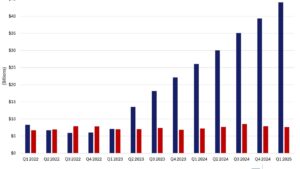Two weeks ago, we wrote about a Wall Street Journal piece titled “Surging Dollar Raises Possibility of Parity With Euro” which explained that the dollar was strengthening against the Euro. Today, the paper printed a new article titled “Dollar’s Climb Stalls Amid Mixed Economic Signals” explaining “The WSJ Dollar Index, which measures the dollar against a basket of 16 currencies, is around 2% off its May peak and fell 1.1% last month.”
Everything the WSJ wrote seems accurate to us, and the paper does a good job of covering economic issues. In addition, we agree with its assessment that currencies tend to rise and fall with the health of the underlying economy and the trend of that currency’s central bank to raise or lower interest rates. We also think the Journal is focused on the wrong thing. As we’ve noted previously, the dollar has been rising against other currencies while also buying much less food, fuel, and shelter. From the point of view of a foreign exchange trader, the dollar has been great this year. From the point of view of the average American, less so.
The Journal also wrote that home sales had fallen and that made some asset managers think that the Federal Reserve would need to slow the pace of interest rate increases. Here’s what we think is happening: Home sales are indeed slowing, and that’s primarily at the low and middle end of the market. As a result, much of the transaction volume taking place is happening at the high end. This is giving a misleading impression that home prices are still rising. A more accurate way of explaining the situation is that when more expensive homes become a higher percentage of overall sales, the average price of a home sale will rise (even though the prices of individual homes may no be rising).
Eventually, the lower end of the market will start to clear at lower prices and the average price of home sales will come down rapidly. This will lower the official inflation numbers on the largest part of the Consumer Price Index as shelter makes up one-third of the CPI. In turn, that will allow the Fed to consider slowing interest rate increases. Here’s the issue as we see it: home prices may come down, but home affordability hasn’t. People don’t have more money for their monthly payments than they had a year ago. With higher interest rates, it just means that while the price that people pay for a new home may come down, the monthly payment will remain the same.
If that’s confusing, here’s an example that will help. If you had bought a home last year for $500,000, made a 20% down payment, and had a mortgage with a 2.875% interest rate, your monthly payment would be $1,660. Today, with mortgage rates around 5.125%, in order to have the same monthly payment, you’d need to pay $375,000 for the same home. While paying less for the home is nice, your ability to afford that home is unchanged even at lower prices.
As we wrote last month, “You might be able to use a dollar to buy more euros, but that same dollar will buy you less gas, food, and housing. Is the dollar strengthening or weakening? That depends on your point of view, but we’d rather have food and fuel than euros.”



